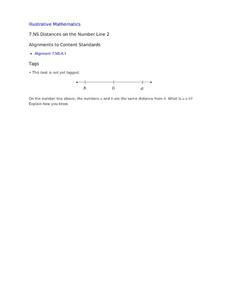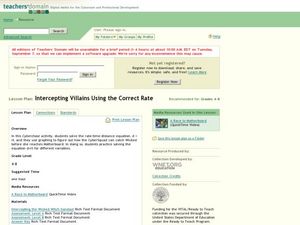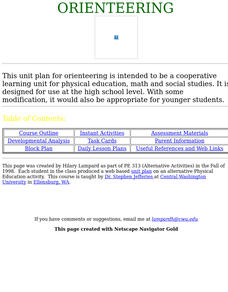Curated OER
Distances on the Number Line 2
Simple tasks are presented for your seventh grade math masters. They are to determine whether two numbers on a number line are equidistant from zero and what the two added together would be.
Curated OER
Velocity of Traffic on Highway 26
Physics fanatics time five cars as they pass on the highway. They use the times and a 20-yard distance to calculate velocity. They also graph distance vs. time. A page of student pre-lab questions is provided in addition to the activity...
Curated OER
Problem Solving: Draw a Diagram
This problem solving PowerPoint presents a detailed, logical sequence of steps to follow in order to solve a story problem. The thinking processes described are given in text and represented by a visual model. After discussing the...
Curated OER
Regents High School Examination - Physics 2010
Give every type of learner in your physics class an opportunity to demonstrate what they have learned throughout the year. From analyzing tables and graphs, to evaluating diagrams and solving problems, there is an outstanding variety of...
Curated OER
Intercepting Villans Using the Correct Rate
A Cyberchase video introduces the distance = rate x time equation. Participants then calculate answers to proposed problems and graph a series of results that is then incorporated into a game to help cement the concept. A thorough and...
Curated OER
Orienteering
Everything you wanted to know about orienteering, and more! Take your class on an adventure with this creative activity. You will need to gather some supplies and materials and maps for your specific location, but the unit sounds like it...
Curated OER
Measurement and Algebraic Thinking
Comparatively speaking, does a bug travel farther than a human in 10 seconds? Get a bug and measure how far it travels in 10 seconds. Have a human team member run for 10 seconds and calculate the distance ran. Answer the question,"Who...
abcteach
Metric Conversions Cheat Sheet
How do you convert inches to centimeters? Or pints to liters? This handy reference guide has both US to metric, and metric to US conversions in a quick, easy-to-read format. Mass, area, volume, capacity, and length conversions are...
Curated OER
Unit III: Worksheet 4 - Uniform Acceleration
Eight problems require general physics recruits to calculate acceleration or distance traveled. They read the situations involving cars and buses, running bears, downhill skiers, and a rock slide and then get to work. Provide this as a...
Curated OER
Displacement vs. Distance Worksheet
Displacement is a foundational concept for physics pupils. If they are having trouble discerning it from distance, this activity can help clear things up. The first page is essentially a piece of graph paper. It has a compass rose and a...
Curated OER
Physics
For this physics worksheet students complete a series of multiple choice and short answer questions on force, magnitude, and energy. They complete calculations to solve word problems.
Curated OER
Dependence of Light Intensity on Distance
Hopefully you have a sensor interface for your physics class to use with graphing calculators when collecting data with a light sensor. If so, read on. Use this resource for learners to predict and then test whether or not the intensity...
Curated OER
Monster Cars: Slope
Students examine how a rate is calculated from two points. Using battery operated cars, pairs of students measure time and distance. Afterward, they use this data to calculate the rate. Students then plot four ordered pairs and discover...
Curated OER
Frisbee Baseball
Students keep track of the number of tosses it takes them to reach each base, and encourage team members and recognize their successes. To make this activity fit the level of older classes, measure distances and figure averages as you play!
Curated OER
How Far Is It?
Students use a map key to estimate the distance from Salt Lake City, Utah, to ten other cities. Then they use an online distance calculator to see how close their estimates come!
Curated OER
How Fast Can You Watch?
In this watch worksheet, pupils read story problems and determine the change in the distance with respect to time. They compute the radians per second. This two-page worksheet contains nine multi-step problems.
Curated OER
Speed Problems
Return to the classic word problem with these speed scenarios. Learners use some combination of the variables speed, distance, and speed to solve six problems, all of which ask for one of these as an answer. The examples do a nice job of...
Curated OER
Motion Basics
Quiz those kids to assess what they've gleaned from your last lesson on Newton's laws of motion. There are 10 questions that have learners define force, acceleration, velocity, and speed. A bonus question has them write a motion story...
Curated OER
Speed Problems
Challenge your fourth graders with these tricky word problems about speed. They use the formula for time, distance, and speed to solve six scenarios. There are three examples, each showing an instance when a different variable must be...
Curated OER
How Far Can You Jump?
Students estimate the distance of student's broad jumps. This activity can take place in the block center with a small group of students. They are explained that they are going to jump from a starting point (marked with the masking...
Curated OER
Simplify Ratio: Word Problems
Use this story problems about ratio worksheet to have learners read word problems with given ratios and find the designated numbers or distances. They solve four problems.
Curated OER
Acceleration Lab
Young Einsteins experiment with the acceleration of Hot Wheels™ toy cars down inclined planes at various angles. This classic physics lab activity is thoroughly explained in both a teacher’s guide and a student lab sheet. Science...
Curated OER
Math Cross, Puzzle #26
Here is a measurement, money and time worksheet which invites learners to solve twenty-eight math problems utilizing addition, subtraction and multiplication strategies to complete a math crossword puzzle.
Curated OER
Decimals, Percents, and Fractions
Learners practice converting fractions, decimals, and percentages to communicate equal amounts. They fill in a table, determine the percentage of a total area that is shaded in diagrams, complete equations with decimals to the hundredths...

























